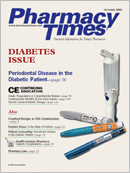Publication
Article
Pharmacy Times
Understanding the Maze of Medicare Part D
Author(s):
The intricacies of the MedicarePart D prescription benefit mayseem overwhelming, but a newoutreach and education program promisesto help patients and pharmacistsnavigate the maze. The program, calledBeneficiary Centered Enrollment (BCE),will focus on "dual eligibles" —the morethan 6 million people, mostly seniorsand those with disabilities, who currentlyget their prescription drug benefitsthrough Medicaid and their otherhealth care through Medicare.
On January 1, 2006, these people'sdrug benefit will switch from Medicaidto one of the new Medicare-approvedplans. If they do not specify which onethey want, they will find themselves ina plan that the government chooses forthem—which may not be the one thatprovides the best coverage for thedrugs they need.
The BCE program will focus on helpingdual eligibles choose the bestMedicare plan and on helping pharmaciststo assist them, according to DavidMedvedeff, president of InformedDecisions. The company, a unit of theclinical drug information providerGold Standard, located in Tampa, Fla,is providing the service. Also in developmentis a free 1-hour accredited continuingeducation course about theMedicare prescription benefit.
The program is funded by theNational Association of Chain DrugStores (NACDS), Eli Lilly, andAstraZeneca and is getting other supportfrom the National CommunityPharmacists Association. The programaims to solve a problem resulting fromthe way the Medicare benefit is beingrolled out. To ensure that dual-eligiblepeople get continuing coverage, thegovernment is automatically and randomlychoosing a Medicare prescriptionplan for them in October, when the formulariesand other details of approvedplans are officially announced. Thesepeople will not be officially enrolled inthe plan, however, until their Medicaiddrug benefit stops at the end of 2005.
The problem, according to officialsof NACDS and Informed Decisions, isthat the plan Medicare chooses maynot be the one that best covers thebeneficiaries' prescription drug needs.As a result, when their benefit switchesto Medicare, they could suffer an interruptionin coverage. Fortunately, theyhave until the end of the year to compareother plans available and toswitch to one that is a better fit.Medvedeff thinks that at least a handfulof plans will be available in eachstate: "enough to create options, butalso to sow confusion," he said.
BCE aims to help dual-eligible peoplecompare plans. It works this way:Participating state Medicaid agencieswill provide Informed Decisions withinformation about the dual-eligibleindividuals living in the state, includingthe medications that they take.Informed Decisions will compare thoseindividuals' prescription needs withthe formularies of each Medicare-approvedplan operating in the state.Then each dual-eligible person will besent a letter that includes a personalized"scorecard," describing whichmedications are covered by each plan.People will be able to enroll in theplans starting November 15.
Pharmacists also will be able to helpdual-eligible people analyze theiroptions, because they will be able toaccess the scorecard information foreach individual via the Internet,Medvedeff said. There will be no chargefor accessing the information, but pharmacieswill need to be stateMedicaid-approved, and they will haveto get each person's permission, he said.
Officials of 3 states already have saidthat they intend to use the service,according to Medvedeff. One of themis Louisiana, which has ~100,000 dualeligibles. Discussions are in progresswith officials of another 14 states,including California, New York, andTexas, he added.
As already mentioned, another elementof the program will be a 1-houraccredited continuing education course,which will be available free on-line andon CD. The course is aimed at pharmacistsand other health care professionals.It will cover the basics of the Medicareprescription benefit, as well as focusingon the limited-income and dual-eligiblegroups, who will be most affected by thebenefit in the short term.
The involvement and education ofpharmacists are key, because, "whenpeople get a letter from Medicare,often the first person they talk to istheir pharmacist," said Stacey Swartz,director of management and educationalaffairs at the National CommunityPharmacists Association.
One goal is to provide pharmacistswith the education and tools to helpmake the transition to Medicare Part Dsmoother than the introduction ofMedicare discount cards was in 2004.
One change that pharmacists mayhave to explain to dual-eligiblesswitching to Medicare is the need forcopayments, which often are notrequired under Medicaid. The copaymentamount will depend on income,starting at $1 for generics and $3 forbranded drugs.
Many other less-specific efforts areunder way to educate those most affectedby the prescription benefit. InOctober the Centers for Medicare andMedicaid Services (CMS) plans to introducean on-line tool for analyzingMedicare prescription plans, aspokesperson said. It is expected to besimilar to a tool that CMS currently providesat its Web site, www.medicare.gov,to help patients compare drug discountcards. This tool lets them enter informationsuch as where they live and themedications they take, then shows a listof cards available, which drugs are coveredby each card, and the copaymentsrequired.
Mr. Faden is a freelance medical writerbased in Portland, Ore.







